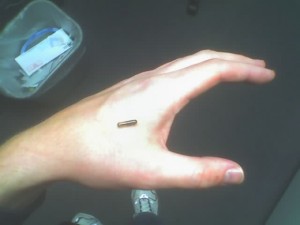MONDAY, 25 APRIL 2011
A question that has always fascinated me is where the line between science fact and science fiction lies; how close to the real world are some of the latest sci-fi books and television shows? And can we get closer to realising these seemingly impossible ideas in the future? The research I have done into this area shocks me, as we are much closer than I had ever imagined. The example I am going to draw upon for this essay is the well known villain from “Doctor Who” – the Cybermen. Debuted in 1966 and created by Dr. Kit Pedlar, the Cybermen have become a staple of the show and are ranked among the Doctor’s most feared enemies. Originating from a human-like species, the Cybermen experimented with cyber modifications, eventually converting their organic bodies into human-machine hybrids or “cyborgs.” Worryingly, this idea is closer to reality than many people expect. One only has to look at inorganic parts already implanted, such as pacemakers, cochlear implants and joint replacements to see that we, as a society, are on the first rung of that ladder. Research by Professor Kevin Warwick, of Reading University, has allowed him to reach the second rung. How long will it be before the rest of humanity follows suit?Warwick is a somewhat controversial scientist with an interest in research that grabs the attention of the media. Some of his experiments have been branded as eye-catching gimmicks, but he is nonetheless at the forefront of what has been achieved in cybernetics. In 1988 Warwick had a silicon device surgically inserted into his left forearm, allowing sensors around his department to recognise his approach and react accordingly by opening doors or activating computers. Already, similar technology is being used in the States’ medical system; a chip containing an individual’s medical records implanted into their arm allows a hospital to ascertain vital information about a patient, even when they are brought in unconscious or unable to communicate. In another application of the technology, the Beja Beach Clubs in Rotterdam and Barcelona contain exclusive areas which can only be accessed by those who have a certain implant. How long will it be before every individual’s details are stored on such a device, dispensing with items such as passports, visas, credit cards and medical warning cards?
In 2002, Warwick released his headline-seeking Project Cyborg 2.0, in which he made a direct link between his brain and a computer by wiring a second chip into his nervous system. By sending signals from his nervous system through the internet Warwick was able to control a robotic hand across the Atlantic in New York by the movement of his own. In a comparable case a similar piece of technology was implanted into the nervous system of Matt Nagle after he was paralysed from the neck down as the result of a knife attack. The device was programmed to recognise certain brain signals, allowing Nagle to move a cursor around a computer screen by thought alone. This supposed telekinesis has several important applications in today’s society and could save and improve many lives. Imagine army equipment which could be controlled by thought, keeping soldiers off the battlefield. Furthermore, Warwick has expressed his belief that this could become a two way system, allowing humanity to “update” our relatively slow organic brains with connections to the internet and other sophisticated programs, thus creating a race of cyborgs with almost limitless brain capacity and thinking ability. On top of that, in another aspect of his experiment Warwick showed that our brains have the capability to process new senses and integrate them into our current sensory system. By linking the device in his arm to an ultrasound emitter and detector Warwick was able to navigate around a room blindfolded by using the same echolocation technique as bats to detect objects in his way. Using similar ideas a new race of cyborgs could theoretically have any number of different senses including infrared, night and X-ray vision.
More recently, Warwick has implanted a similar silicon chip into his wife’s arm. He claims that he and his wife, Irena, are able to “communicate” directly from one nervous system to the other. When Irena wiggled her fingers, the electrical impulses of her nervous system were recorded by the chip and sent, via the internet, to the chip in Warwick’s arm, giving him a “tingling sensation, like a mild electric shock.” This enabled him to identify when she was moving her hand. Although this is a far cry from true telepathy it marks an important milestone and suggests that this fantastical ability may one day be the norm. The mind reels at the benefits this could give humanity. Direct mental communication would provide almost instantaneous sharing of emotions or data, allowing humans to send important information, such as the location of a landmine, quickly enough for it to be of use to the recipient. However, this new technology could be exploited all too easily, leading to an invasion of personal privacy, forced transparency and abuse of the software by antagonistic parties. Steps must be taken in the future to ensure Warwick’s ultimate goal of humans communicating through thought rather than speech, is not used for destructive ends.
As exciting as the implications of these potential cyborgs are, there are several ethical dilemmas that need to be addressed. This is exemplified by the fact that Warwick’s work was on the agenda for The President’s Council on Bioethics in America. Humans are the dominant species on the planet because of their superior intelligence - it is why we are able to create such advanced technologies, but also why we do not ask advice on important issues from the animal kingdom; both their communication methods and intelligence, and therefore input, is wildly inferior to ours. How, therefore, would a new race of beings, superior in every way, treat those who have not been upgraded? Would a divide form and our species diverge, leaving the two strands unable to communicate? Would evolution root out humanity in favour of the more advanced cyborgs? Would the cyborgs themselves attempt to eradicate humanity in order to rid themselves of a potential rival for power? Should strict regulations be introduced in order to prevent individuals giving themselves superhuman abilities? For years humans have been changing the world around them to suit their needs but now we are discovering the ability to improve ourselves beyond recognition.
There are many valid arguments, not least religious objections, against using cybernetics to enhance humans and many safety tests will have to be carried out before this technology is open to the public. However, according to Warwick we may have less time than we think. He argues that in the same way that cyborgs may see humanity as inferior due to their inferior intelligence, computers themselves may soon come to be cleverer than us due to developments in artificial intelligence. Could real life start to parallel films like The Matrix or I, Robot? Is the only way to compete with ever more intelligent software to make ourselves more intelligent too? This implies that we will have to modify ourselves to survive; a cybernetic parallel to evolution.
I have asked many more questions than I have answered here, and I expect the answers will not become clear until we reach that particular level of cybernetic sophistication. Either way we should all be more careful about how we treat science fictional ideas; the line between these ideas and science fact has become that bit hazier.
Written by KT Roberts



